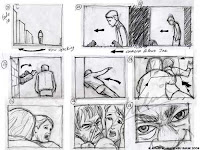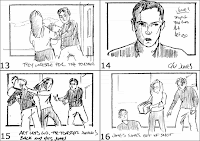A script is an essential part of any film or play. It is important that a script covers all the details aspects of the dialogue in the film. In our trailer, there is not a lot of talking. We chose to do this as we thought as a horror trailer, the absence of dialogue and speech is more likely to create suspense.
The speech we included in our trailer was that of a news reporter near the start of our trailer describing the killings that had been taken place and stating it was a 'massacre' helping to establish the viewers understanding of the trailer as a whole. In my opinion this is effective as the viewer is able to gain a lot of information through the news report of the journalist (acted by my friend Mary).
In order to enhance the news reports, we decided to have voiceovers overlapping eachother to again reinforce the fact that there had been many killings in different areas. We recorded ourselves using a mobile phone and recorded a line each in different voices in order to emphasize the fact that the news reporters were of both genders, male and also females. This was quite funny as it meant that I had to do an impersonation of a man.
Below is the script in which we followed whilst recording the reporting scene.
Reporter 1(on screen)- 'Good evening, I am live at Hampshire Valleys where a death has been reported yesterday night around 11pm. The young woman has not been identified yet however police and forensics are now on the case. This is similar to two attacks in the same borough around the same time. This mysterious event has been described as a massacre. This is Mary Johnson reporting for ABC News, Goodnight'
Reporter 2(voice over)- Another murder at 11:54pm in which another girl has been found brutally killed, left with no identification. She was thought to be....
Reporter 3 (voice over)- Yet another young woman found cobvered in blood after walking her dog at the park in Hampshire Valleys. It is assumed she has been here overnight. Police and forensics are....
After we had recorded the reporting scene, we decided that we should shorten the scene and also the voiceovers as to not bore the viewers. We used the editing facilities on iMovie HD and cut the bits we felt were the most important.
Below I have included images of various horror film scripts from films: Dracula and Orgy of the dead. (Please click them to enlarge them)





 Character 1- The first character we see in the trailer is the news reporter who is played by Mary Adebusyi. Marys position as a news reporter was to inform the viewers of the many deaths that has been taking place in the form of a news report. In order to establish the location and make it seem as though there had actually been a murder there, we bought black and yellow hazard tape in order to suggest a blockage of the area due to the death. As Mary is not a member of my Sixth Form I phoned her on several occasions and discussed days in which she will be available to come to the school and film as our shooting location was nearby. On the day of the recording, I supplied Mary with a script and she helped to stick the tape on the brick walls which was difficult as they were not sticking properly. As it began to rain, both I and Mary were beginning to get stressed as we had to do many takes in order to decide the best one and also I had to film shots from many different angles. Overall, Mary was happy with the clips I had recorded of her, she said:
Character 1- The first character we see in the trailer is the news reporter who is played by Mary Adebusyi. Marys position as a news reporter was to inform the viewers of the many deaths that has been taking place in the form of a news report. In order to establish the location and make it seem as though there had actually been a murder there, we bought black and yellow hazard tape in order to suggest a blockage of the area due to the death. As Mary is not a member of my Sixth Form I phoned her on several occasions and discussed days in which she will be available to come to the school and film as our shooting location was nearby. On the day of the recording, I supplied Mary with a script and she helped to stick the tape on the brick walls which was difficult as they were not sticking properly. As it began to rain, both I and Mary were beginning to get stressed as we had to do many takes in order to decide the best one and also I had to film shots from many different angles. Overall, Mary was happy with the clips I had recorded of her, she said:





